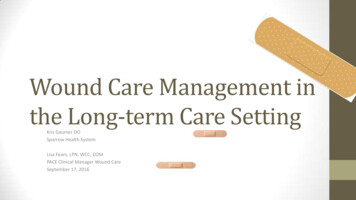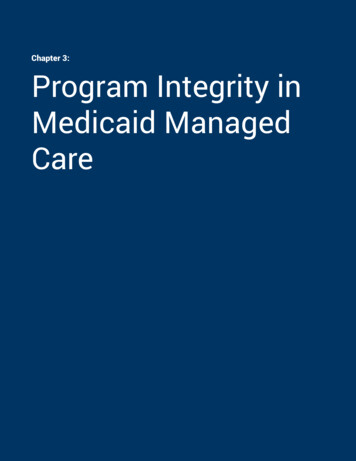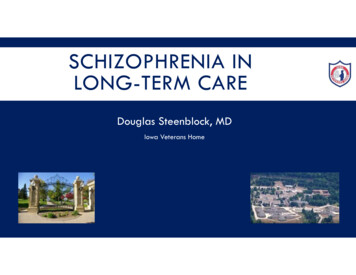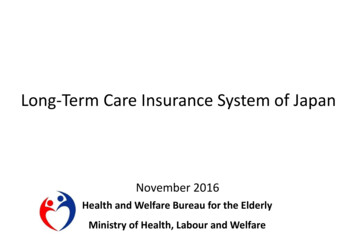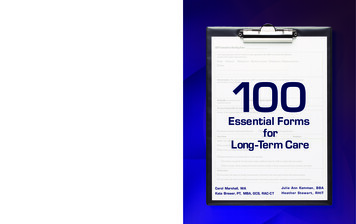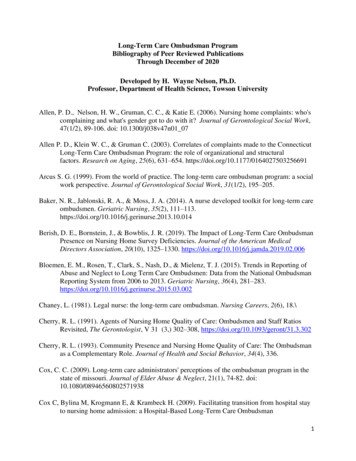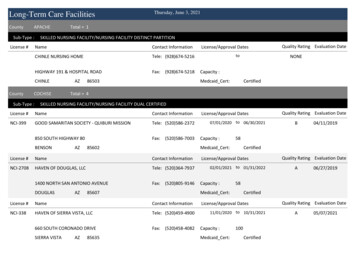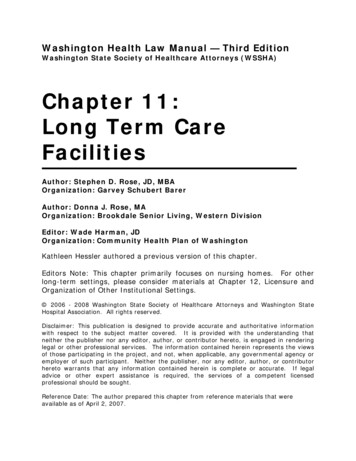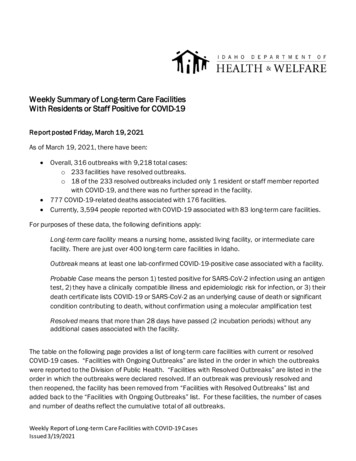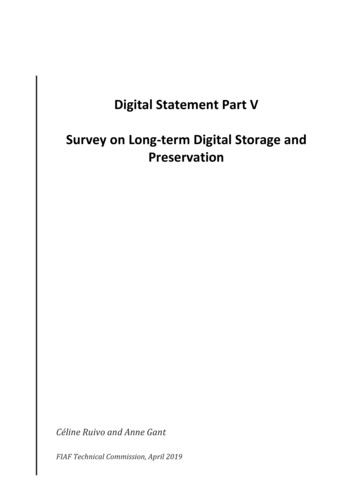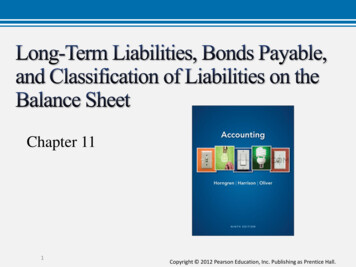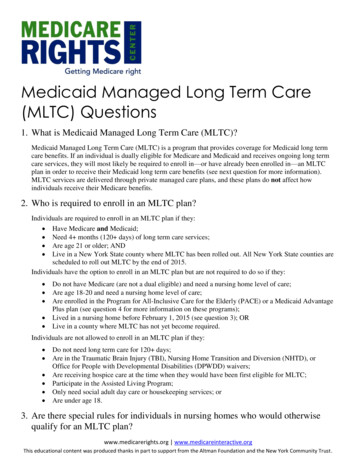
Transcription
Medicaid Managed Long Term Care(MLTC) Questions1. What is Medicaid Managed Long Term Care (MLTC)?Medicaid Managed Long Term Care (MLTC) is a program that provides coverage for Medicaid long termcare benefits. If an individual is dually eligible for Medicare and Medicaid and receives ongoing long termcare services, they will most likely be required to enroll in—or have already been enrolled in—an MLTCplan in order to receive their Medicaid long term care benefits (see next question for more information).MLTC services are delivered through private managed care plans, and these plans do not affect howindividuals receive their Medicare benefits.2. Who is required to enroll in an MLTC plan?Individuals are required to enroll in an MLTC plan if they:Have Medicare and Medicaid;Need 4 months (120 days) of long term care services;Are age 21 or older; ANDLive in a New York State county where MLTC has been rolled out. All New York State counties arescheduled to roll out MLTC by the end of 2015.Individuals have the option to enroll in an MLTC plan but are not required to do so if they:Do not have Medicare (are not a dual eligible) and need a nursing home level of care;Are age 18-20 and need a nursing home level of care;Are enrolled in the Program for All-Inclusive Care for the Elderly (PACE) or a Medicaid AdvantagePlus plan (see question 4 for more information on these programs);Lived in a nursing home before February 1, 2015 (see question 3); ORLive in a county where MLTC has not yet become required.Individuals are not allowed to enroll in an MLTC plan if they:Do not need long term care for 120 days;Are in the Traumatic Brain Injury (TBI), Nursing Home Transition and Diversion (NHTD), orOffice for People with Developmental Disabilities (DPWDD) waivers;Are receiving hospice care at the time when they would have been first eligible for MLTC;Participate in the Assisted Living Program;Only need social adult day care or housekeeping services; orAre under age 18.3. Are there special rules for individuals in nursing homes who would otherwisequalify for an MLTC plan?www.medicarerights.org www.medicareinteractive.orgThis educational content was produced thanks in part to support from the Altman Foundation and the New York Community Trust.
As mentioned in question 2, individuals who lived in nursing homes before February 1, 2015 have theoption to enroll in an MLTC plan if they choose to. However, they are not required to do so.If someone is already in an MLTC plan and then enters a nursing home, they must remain in their MLTCplan. MLTC plans must contract with any nursing home in which their members reside.People who move into a nursing home after February 1, 2015 are also required to enroll into an MLTC plan.4. What are PACE and Medicaid Advantage Plus plans?Program for All-Inclusive Care for the Elderly (PACE) plans provide all of a member’s Medicare andMedicaid benefits, including prescription drug coverage. Individuals qualify for a PACE plan if they:Are aged 55 ;Live in an area serviced by a PACE program;Meet the state's standards for needing nursing home-level care; andSign and agree to the PACE enrollment agreements.PACE covers all needed medical, social, and rehabilitative services for qualifying individuals, includingitems that Medicare does not cover, such as social work services, meals, and adult day health care. PACEcoordinates all Medicare and Medicaid services, usually at a specific PACE location.Medicaid Advantage Plus plans also provide all of a member’s Medicare and Medicaid benefits, includingprescription drug coverage. Individuals are eligible for a Medicaid Advantage Plus plan if they are dualeligibles who meet the state’s standards for needing nursing home-level care.To enroll in a Medicaid Advantage Plus plan, an individual must enroll in both the Medicare and Medicaidmanaged care plans that the private health insurance company offers. These two components of theircoverage then work together to provide all of a member’s Medicare and Medicaid benefits, includingMedicare services, Part D prescription drug coverage, Medicaid long term care services, and other Medicaidservices.5. Can an eligible individual choose not to enroll in an MLTC plan?Individuals who meet the four criteria outlined in question 4 are typically required to enroll in an MLTCplan (unless they qualify for an exception). The MLTC enrollment requirement can be met by choosing anMLTC plan, a PACE plan, a Medicaid Advantage Plus plan, or a FIDA plan (starting in 2015).Additionally, an individual may switch into a different plan, or a different type of plan, up to once permonth.6. Where is MLTC happening?MLTC plans were first offered solely in New York City in 2012. Since then, the MLTC program hasgradually expanded to most counties in New York State. By the end of 2015, all counties in New YorkState will require those who are eligible to enroll in an MLTC plan.7. What benefits are provided by MLTC plans?Remember, having an MLTC plan does not affect an individual’s Medicare benefits. MLTC plans provideall Medicaid long term care benefits in addition to dental, eye, hearing, and foot care. MLTC benefitsinclude:Home care (e.g., personal care, nursing care, physical and occupational therapy)Adult day health care Medicare Rights Center 2015Page 2This educational content was produced thanks in part to support from the Altman Foundation and the New York Community Trust.
Home-delivered meals, congregate mealsMedical equipment, durable medical equipment, eyeglasses, and hearing aidsCertain home modificationsNon-emergency medical transportationPodiatry, audiology, dentistry, and optometryNursing home careCare managero Note that some MLTC beneficiaries have had trouble accessing their care manager. Individualswho cannot get in touch with their MLTC care manager should file a grievance with their plan(see question 12) and report the issue to the New York Department of Health Complaint Hotlineat 866-712-7197.Remember PACE and Medicaid Advantage Plus plans cover different services than MLTC alone, asoutlined in question 4.Note: Members admitted to a nursing home are allowed to keep their MLTC plan but are not required to doso. See question 3 for more information.8. Do individuals enrolled in MLTC plans receive the same amount of care asbefore?Enrolling in an MLTC plan does not change the amount or type of long term care services available to dualeligible beneficiaries. When an individual newly enrolls in an MLTC plan, they are given a transitionperiod. During this time they can receive the same amount of care from the same providers they were usingbefore they enrolled in the MLTC plan. This transition period lasts up to 90 days (3 months) or when theircare assessment is complete, whichever is first. See question 9 for more information about care assessments.9. What assessments are conducted to determine MLTC enrollees’ care needs?An individual must first be certified to need 120 days of long term care before they can enroll in an MLTCplan. Previously, this determination was made by their long term care provider, such as the home healthagency, adult day health care site, or nursing home. However, the State is phasing in a new conflict-freeevaluation. The phase-in of the conflict-free evaluation began for newly eligible MLTC beneficiaries inManhattan and the Bronx on October 1, 2014, and is scheduled to be available for the rest of New York Cityby November 1, 2014. It will then be gradually phased in to the rest of the state by May 2015. When anindividual requests ongoing long term care services, the Conflict-Free Evaluation and Enrollment Center(CFEEC) will send a nurse to the individual’s home to assess whether they will need 120 days of long termcare. To schedule an evaluation, an individual can call the CFEEC at 855-222-8350.Once the evaluation is complete, individuals can request a care needs assessment from the MLTC plan(s)that they are interested in enrolling in. This is not a request for enrollment, but simply an initial assessment.This assessment takes into account an individual’s current needs to determine needed MLTC services. Theplan may also assess the individual’s home to ensure that it is a safe and appropriate space for meeting longterm care needs. Keep in mind that a plan cannot require an individual to enroll on the spot once it conductsan assessment, nor can it only conduct an assessment if the individual agrees to enroll. Individuals canrequest assessments from as many MLTC plans as they want before choosing a plan.Once an individual enrolls in an MLTC plan, a separate assessment should be conducted by their planwithin 30 days of enrollment. The MLTC plan will then use the assessment to formally create a plan of care,which lays out exactly what services the member will be receiving. The member should receive a copy ofthe plan of care. MLTC enrollees should receive a new assessment at least every 6 months, or when there isa significant change in their condition. If the enrollee does not agree with the care plan, they can file anappeal (see question 11). Remember, they can also switch to a different plan at any time during the year. Medicare Rights Center 2015Page 3This educational content was produced thanks in part to support from the Altman Foundation and the New York Community Trust.
10. When individuals join an MLTC plan, will they be able to continue to receivehome health assistance through the Consumer Directed Personal AssistanceProgram (CDPAP)?The Consumer Directed Personal Assistance Program (CDPAP) allows the Medicaid beneficiary and/ortheir caregivers to have more control over how they receive personal assistance home care services.Typically, Medicaid beneficiaries must receive their home care from an aide who works for an approvedagency. Offering a more patient-centered path to care, CDPAP allows the beneficiary to choose their owncare provider, meaning that their new aide does not have to work for an agency. Rather, the aide can be afamily member, friend, or other professional who is capable of providing the needed care. The beneficiaryand/or their caregivers decide on the level of training their aide needs. The aide then gets paid by theMedicaid program (through a fiscal intermediary).Individuals enrolled in MLTC must be able to continue to use CDPAP if they so choose. To do so, theymust notify their plan of their intention to use this program and coordinate their own care. Individuals whoare unable to coordinate their own care can appoint a caregiver or family member. The plan will then assesswhether the beneficiary or their appointed representative is able to appropriately coordinate care. Individualswhose plan denies their request to participate in CDPAP can file an appeal using the information in question11.11. What can a member do if they disagree with their MLTC plan’s care decision?An MLTC enrollee who disagrees with their plan’s care decision should appeal. An appeal is a formalrequest for the MLTC plan to reconsider its coverage decision. Members can file an appeal any time theirMLTC plan denies, reduces, or ends care they think they should receive. An appeal can be filed either orallyor in writing by following the instructions on the written notice of denial that they member receive.There are two ways to file an appeal:1. Standard Appeal: File this kind of appeal with the MLTC plan within 45 days of receiving the noticeof denial of coverage. Appeals can be filed by following the instructions on this notice; calling thenumber on the MLTC card and asking to be transferred to the Appeals and Grievances Department;or contacting the MLTC care manager. The plan will review its decision and make a new coveragedecision within 30 days of receiving a standard appeal.o If a member needs services right away, an expedited appeal can be filed. The member will bemore successful in being granted an expedited appeal if their doctor writes a letter of supportexplaining why not receiving the care will put their life or health in danger. If an expeditedappeal is granted, the MLTC plan must make a decision within three days.2. Fair Hearing: File this type of appeal directly with the state within 60 days of receiving notice ofdenial of coverage. A fair hearing is an opportunity to explain to a state-appointed AdministrativeLaw Judge (ALJ) why the MLTC plan’s decision was wrong.o To request a fair hearing: In person – Go to the local Department of Social Services (Medicaid office). Over the phone – Call 800-342-3334. Online – Go to http://otda.ny.gov/oah/FHReq.asp. Via fax – Download and complete the appeal form fromhttp://otda.ny.gov/oah/FHReq.asp and send it to 518-473-6735. Through the mail – Download and print the form linked above and send it to the NewYork State Office of Temporary and Disability Assistance, Office of AdministrativeHearings, P.O. Box 1930, Albany, New York 12201-1930. Medicare Rights Center 2015Page 4This educational content was produced thanks in part to support from the Altman Foundation and the New York Community Trust.
Keep in mind that individuals who are appealing are not required to file an appeal with their plan beforeapplying for a fair hearing. That said, if an appeal to the plan is denied, an individual can then also apply fora fair hearing. The reverse is not true. If a fair hearing appeal is denied, an individual cannot then file anappeal with the MLTC plan.If an individual’s care is being reduced or ending and the appeal is filed at least 10 days before the care isset to change, the individual can continue to receive the same amount of care throughout their appeal. Thisis known as aid continuing. If the appeal is successful, the individual will continue to receive the sameamount of care as before. If the appeal is unsuccessful, the scheduled decrease or end of care will occur.12. How do I file a complaint (grievance) with my MLTC plan?A grievance is a complaint that an individual files with their plan. It is not an appeal and is not a request forcare to be covered. Instead, it is a complaint about something the plan has said or done. Grievances are filedover the phone or in writing, and the MLTC care manager or member handbook can provide furtherinstructions. Members can also call the customer service number on their MLTC card and asked to betransferred to the Grievance Department.In the grievance, the member should include as many details as possible about the situation that caused thecomplaint. The MLTC plan must respond to the grievance within 45 days of receiving all of the informationabout the grievance, and no more than 60 days in total. If the member or the member’s health care providerbelieves they need a quicker decision to avoid serious harm to the member’s health or ability to function, anexpedited grievance can be filed. For an expedited grievance, the MLTC plan must make a decision within48 hours of receiving all of the information, and no more than seven days in total.If a member believes their grievance was handled improperly or it is an emergency, they can call the NewYork State Department of Health MLTC Complaint Hotline at 866-712-7197.13. How does an individual enroll in an MLTC plan?Individual who are newly eligible for an MLTC plan can enroll by calling New York Medicaid Choice at888-401-6582 or visiting www.nymedicaidchoice.com. New York Medicaid Choice will help individualsexplore their plan options and enroll in a plan. See question 14 for factors individuals should consider whenchoosing a plan.Individuals who enroll by the 15th of the month will see their MLTC coverage start on the 1st of thefollowing month. For example, if an individual enrolled in a plan on January 15th, their MLTC plan coverwould begin on February 1st. However, if an individual enrolled in a plan on January 20th, their MLTC plancoverage would not begin until March 1st. Keep in mind that a beneficiary is allowed to switch to a differentMLTC plan at any time during the year.14. How does an individual effectively choose an MLTC plan?Individuals should follow these steps to find the MLTC plan that best meets their needs:Make a list of all the health providers they use for their long term care services, foot care, eye care,hearing care, and dental care.Call New York Medicaid Choice at 888-401-6582.Share the list of providers with Medicaid Choice. Medicaid Choice will help them find a plan thatincludes all or most of the providers.o If a provider is not in an MLTC plan’s network, the individual may have to switch to adifferent provider that is in-network to avoid having to pay the full cost of the care.Choose a plan that includes all or most of the providers.New York Medicaid Choice will enroll the individual in that plan. Medicare Rights Center 2015Page 5This educational content was produced thanks in part to support from the Altman Foundation and the New York Community Trust.
15. Are there rules that MLTC plans have to follow when marketing to potentialmembers?There are marketing rules that MLTC plans must follow in order to ensure that consumers are not misledand are fully aware of their options. Insurance companies and their representatives are not allowed tomarket their MLTC plans by:Going door to doorMaking one-on-one appointments between sales representatives and consumers without consumerpermissionCalling consumers without their permissionProviding consumers with gifts (money or otherwise) only if they enrollMarketing in hospital emergency rooms, treatment rooms, hospital patient rooms, medicalprofessional offices, nursing home or adult care facility resident rooms, adult day health careprograms, or social day care sitesInsurance companies and their representatives are allowed to market their MLTC plans by:Offering gifts with a value of no more than 5 if the gift is offered regardless of whether a consumerenrolls in the planScheduling marketing activities in a non-excluded area of a health care facility with the provider’spermissionMaking one-on-one appointments between sales representatives and consumers with consumerpermissionCalling consumers after receiving permissionIf an MLTC plan or its representative has violated any of these marketing rules, an individual should collectas many details as possible—such as day, time, location, and exactly what happened. They should then callthe New York State Department of Health Complaint Hotline at 866-712-7197 to report the incident.16. Who can help answer questions or address problems with MLTC plans?Depending on the issue, there are a number of options:MLTC care manager – The care manager is assigned by the plan and should be able to answerquestions about plan benefits and network. If a beneficiary doesn’t know who their care manager is,they should call the number on their MLTC card to find out.File a grievance – A grievance is a formal complaint to an MLTC plan about its actions or decisions(see question 12). It is different than an appeal, which is when an individual asks their plan toreconsider its coverage decision (see question 11). In some cases, an individual may want to file bothan appeal and a grievance.o New York State Department of Health Complaint Hotline – As noted in question 12, anindividual can also call this hotline with complaints or grievances about an MLTC plan: 866712-7197.New York Medicaid Choice – Contact New York Medicaid Choice with any questions aboutswitching or enrolling in an MLTC plan: 888-401-6582 or www.nymedicaidchoice.com.All members can always contact the FIDA/MLTC Ombudsman in New York State called theIndependent Consumer Advocacy Network (ICAN) at 844-614-8800. Medicare Rights Center 2015Page 6This educational content was produced thanks in part to support from the Altman Foundation and the New York Community Trust.
The MLTC enrollment requirement can be met by choosing an MLTC plan, a PACE plan, a Medicaid Advantage Plus plan, or a FIDA plan (starting in 2015). Additionally, an individual may switch into a different plan, or a different type of plan, up to once per month. 6. Where is MLTC happening? MLTC
